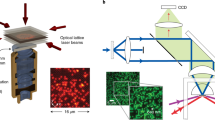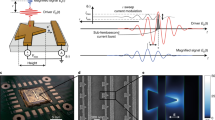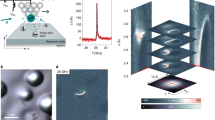Abstract
Scanning probe microscopes are widely used to study surfaces with atomic resolution in many areas of nanoscience. Ultracold atomic gases trapped in electromagnetic potentials can be used to study electromagnetic interactions between the atoms and nearby surfaces in chip-based systems. Here we demonstrate a new type of scanning probe microscope that combines these two areas of research by using an ultracold gas as the tip in a scanning probe microscope. This cold-atom scanning probe microscope offers a large scanning volume, an ultrasoft tip of well-defined shape and high purity, and sensitivity to electromagnetic forces (including dispersion forces near nanostructured surfaces). We use the cold-atom scanning probe microscope to non-destructively measure the position and height of carbon nanotube structures and individual free-standing nanotubes. Cooling the atoms in the gas to form a Bose–Einstein condensate increases the resolution of the device.
This is a preview of subscription content, access via your institution
Access options
Subscribe to this journal
Receive 12 print issues and online access
$259.00 per year
only $21.58 per issue
Buy this article
- Purchase on Springer Link
- Instant access to full article PDF
Prices may be subject to local taxes which are calculated during checkout






Similar content being viewed by others
References
Bhushan, B. Handbook of Nanotechnology (Springer, 2010).
Binnig, G., Quate, C. F. & Gerber, C. Atomic force microscope. Phys. Rev. Lett. 56, 930–933 (1986).
Giessibl, F. J. Advances in atomic force microscopy. Rev. Mod. Phys. 75, 949–983 (2003).
Binnig, G., Rohrer, H., Gerber, C. & Weibel, E. Tunneling through a controllable vacuum gap. Appl. Phys. Lett. 40, 178–180 (1982).
Binnig, G. & Rohrer, H. Scanning tunneling microscopy—from birth to adolescence. Rev. Mod. Phys. 59, 615–625 (1987).
Kaiser, W. J. & Bell, L. D. Direct investigation of subsurface interface electronic structure by ballistic-electron-emission microscopy. Phys. Rev. Lett. 60, 1406–1409 (1988).
Martin, Y. & Wickramasinghe, H. Magnetic imaging by force microscopy with 1000 Å resolution. Appl. Phys. Lett. 50, 1455–1457 (1987).
Xu, J., Laeuger, K., Dransfeld, K. & Wilson, I. Thermal sensors for investigation of heat transfer in scanning probe microscopy. Rev. Sci. Instrum. 65, 2262–2266 (1994).
Frisbie, C. D., Rozsnyai, L. F., Noy, A., Wrighton, M. S. & Lieber, C. M. Functional group imaging by chemical force microscopy. Science 265, 2071–2074 (1994).
Sugimoto, Y. et al. Chemical identification of individual surface atoms by atomic force microscopy. Nature 446, 64–67 (2007).
Ouyang, Z., Hu, J., Chen, S., Sun, J. & Li, M. Molecular patterns by manipulating DNA molecules. J. Vac. Sci. Technol. B 15, 1385–1387 (1997).
Günther, A. et al. Combined chips for atom optics. Phys. Rev. A 71, 063619 (2005).
Wildermuth, S. et al. Microscopic magnetic-field imaging. Nature 435, 440 (2005).
Aigner, S. et al. Long-range order in electronic transport through disordered metal films. Science 319, 1226–1229 (2008).
McGuirk, J. M., Harber, D. M., Obrecht, J. M. & Cornell, E. A. Alkali–metal adsorbate polarization on conducting and insulating surfaces probed with Bose–Einstein condensates. Phys. Rev. A 69, 062905 (2004).
Tauschinsky, A., Thijssen, R. M. T., Whitlock, S., van Linden van den Heuvell, H. B. & Spreeuw, R. J. C. Spatially resolved excitation of Rydberg atoms and surface effects on an atom chip. Phys. Rev. A 81, 063411 (2010).
Biercuk, M. J., Uys, H., Britton, J. W., VanDevender, A. P. & Bollinger, J. J. Ultrasensitive detection of force and displacement using trapped ions. Nature Nanotech. 5, 646–650 (2010).
Jones, M. P. A., Vale, C. J., Sahagun, D., Hall, B. V. & Hinds, E. A. Spin coupling between cold atoms and the thermal fluctuations of a metal surface. Phys. Rev. Lett. 91, 080401 (2003).
Kasch, B. et al. Cold atoms near superconductors: atomic spin coherence beyond the Johnson noise limit. New. J. Phys. 12, 065024 (2010).
Scheel, S. & Buhmann, S. Y. Macroscopic quantum electrodynamics—concepts and applications. Acta Physica Slovaca 58, 675–809 (2008).
Antezza, M., Pitaevskii, L. P. & Stringari, S. Effect of the Casimir–Polder force on the collective oscillations of a trapped Bose–Einstein condensate. Phys. Rev. A. 70, 053619 (2004).
Obrecht, J. M. et al. Measurement of the temperature dependence of the Casimir–Polder force. Phys. Rev. Lett. 98, 063201 (2007).
Cornell, E. A. & Wieman, C. E. Nobel Lecture: Bose–Einstein condensation in a dilute gas, the first 70 years and some recent experiments. Rev. Mod. Phys. 74, 875–893 (2002).
Ketterle, W. Nobel lecture: When atoms behave as waves: Bose–Einstein condensation and the atom laser. Rev. Mod. Phys. 74, 1131–1151 (2002).
Fortágh, J. & Zimmermann, C. Magnetic microtraps for ultracold atoms. Rev. Mod. Phys. 79, 235–289 (2007).
Dalfovo, F., Giorgini, S., Pitaevskii, L. & Stringari, S. Theory of Bose–Einstein condensation in trapped gases. Rev. Mod. Phys. 71, 463–512 (1999).
Fortágh, J., Ott, H., Kraft, S., Günther, A. & Zimmermann, C. Bose–Einstein condensates in magnetic waveguides. Appl. Phys. B 76, 157–163 (2003).
Li, W. et al. Large-scale synthesis of aligned carbon nanotubes. Science 274, 1701–1703 (1996).
Ren, Z. et al. Synthesis of large arrays of well-aligned carbon nanotubes on glass. Science 282, 1105–1107 (1998).
Ketterle, W., Durfee, D. & Stamper-Kurn, D. Making, probing and understanding Bose–Einstein condensates. Proceedings of the International School of Physics—Enrico Fermi (eds Inguscio, M., Stringari, S. & Wieman, C. E.) 67–176 (IOS, 1999).
Hunger, D. et al. Resonant coupling of a Bose–Einstein condensate to a micromechanical oscillator. Phys. Rev. Lett. 104, 143002 (2010).
Lin, Y., Teper, I., Chin, C. & Vuletić, V. Impact of the Casimir–Polder potential and Johnson noise on Bose–Einstein condensate stability near surfaces. Phys. Rev. Lett. 92, 050404 (2004).
Druzhinina, V., Mudrich, M., Arnecke, F., Madroñero, J. & Buchleitner, A. Thermal disequilibrium effects in quantum reflection. Phys. Rev. A 82, 032714 (2010).
Pitaevskii, L. & Stringari, S. Bose–Einstein Condensation (Oxford Univ. Press, 2003).
Jackson, J. D. Classical Electrodynamics, 2nd edn (Wiley, 1975).
Wimberger, S. et al. Topical issue: hybrid quantum systems—new perspectives on quantum state control. Euro Phys. J. D, (in the press).
Singh, M. et al. One-dimensional lattice of permanent magnetic microtraps for ultracold atoms on an atom chip. J. Phys. B 41, 065301 (2008).
Folman, R. et al. Controlling cold atoms using nanofabricated surfaces: atom chips. Phys. Rev. Lett. 84, 4749–4752 (2000).
Inouye, S. et al. Observation of Feshbach resonances in a Bose–Einstein condensate. Nature 392, 151–154 (1998).
Hommelhoff, P., Hänsel, W., Steinmetz, T., Hänsch, T. & Reichel, J. Transporting, splitting and merging of atomic ensembles in a chip trap. New J. Phys. 7, 3 (2005).
Farkas, D. M. et al. A compact, transportable, microchip-based system for high repetition rate production of Bose–Einstein condensates. Appl. Phys. Lett. 96, 093102 (2010).
Günther, A., Bender, H., Stibor, A., Fortágh, J. & Zimmermann, C. Observing quantum gases in real time: single-atom detection on a chip. Phys. Rev. A 80, 011604 (2009).
Acknowledgements
The authors thank S. Scheel, R. Walser and H. Hölscher for helpful discussions. The project was funded by the BMBF (NanoFutur 03X5506). M.G. acknowledges financial support from the Evangelisches Studienwerk e.V. Villigst, P.S. from the Studienstiftung des Deutschen Volkes, and A.G. and T.E.J. from the Baden-Württemberg RiSC programme.
Author information
Authors and Affiliations
Contributions
A.G. and J.F. contributed to the experimental idea and supervised the project. M.G., P.S., A.G. and J.F. designed and set up the experiment. G.V., M.H. and D.P.K. fabricated the nano structures. M.G., P.S. and P.F. performed the experiments. M.G., P.S., T.E.J., A.G. and J.F. analysed the data. All authors discussed the results.
Corresponding authors
Ethics declarations
Competing interests
The authors declare no competing financial interests.
Rights and permissions
About this article
Cite this article
Gierling, M., Schneeweiss, P., Visanescu, G. et al. Cold-atom scanning probe microscopy. Nature Nanotech 6, 446–451 (2011). https://doi.org/10.1038/nnano.2011.80
Received:
Accepted:
Published:
Issue Date:
DOI: https://doi.org/10.1038/nnano.2011.80
This article is cited by
-
Cascaded collimator for atomic beams traveling in planar silicon devices
Nature Communications (2019)
-
3D-printed components for quantum devices
Scientific Reports (2018)
-
A minimalistic and optimized conveyor belt for neutral atoms
Scientific Reports (2017)
-
Stochastic quantum Zeno-based detection of noise correlations
Scientific Reports (2016)
-
Comparison of loading double-loop microtraps from a surface MOT and a FORT
Applied Physics B (2014)



